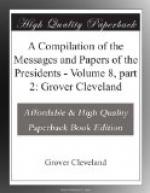The testimony of Talbot, an apprentice, who was with Riggin, is that the outbreak in which they were involved began by a Chilean sailor’s spitting in the face of Talbot, which was resented by a knockdown. It appears that Riggin and Talbot were at the time unaccompanied by others of their shipmates. These two men were immediately beset by a crowd of Chilean citizens and sailors, through which they broke their way to a street car, and entered it for safety. They were pursued, driven from the car, and Riggin was so seriously beaten that he fell in the street apparently dead. There is nothing in the report of the Chilean investigation made to us that seriously impeaches this testimony. It appears from Chilean sources that almost instantly, with a suddenness that strongly implies meditation and preparation, a mob, stated by the police authorities at one time to number 2,000 and at another 1,000, was engaged in the assault upon our sailors, who are represented as resisting “with stones, clubs, and bright arms.” The report of the intendente of October 30 states that the fight began at 6 p.m. in three streets, which are named; that information was received at the intendencia at 6.15, and that the police arrived on the scene at 6.30, a full half hour after the assault began. At that time he says that a mob of 2,000 men had collected, and that for several squares there was the appearance of a “real battlefield.”
The scene at this point is very graphically set before us by the Chilean testimony. The American sailors, who after so long an examination have not been found guilty of any breach of the peace so far as the Chilean authorities are able to discover, unarmed and defenseless, are fleeing for their lives, pursued by overwhelming numbers, and fighting only to aid their own escape from death or to succor some mate whose life is in greater peril. Eighteen of them are brutally stabbed and beaten, while one Chilean seems from the report to have suffered some injury, but how serious or with what character of weapon, or whether by a missile thrown by our men or by some of his fellow-rioters, is unascertained.




